They will see us waving from such great heights
"Come down now," they'll say.
But everything looks perfect from far away
"Come down now," but we'll stay. -The Postal Service
It isn't the weekend, but I'd feel terrible showing you these pictures without giving you the right song to take you through it, so here's Iron & Wine's cover of a great song by The Postal Service:

It's taken over 30 years to get the second spacecraft launched and headed towards Mercury, but Messenger is there now, having performed three flybys and taken even better pictures than Mariner 10 had to offer.
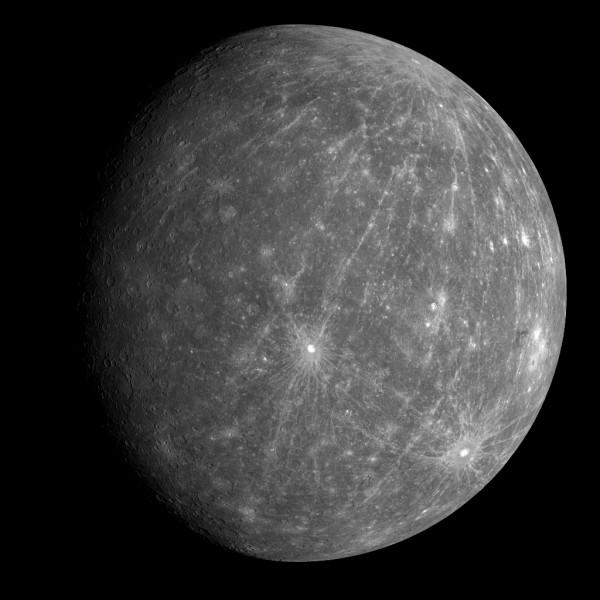
You'll notice that this world looks more like the Moon than any other planet we know of. It's full of craters, for one.
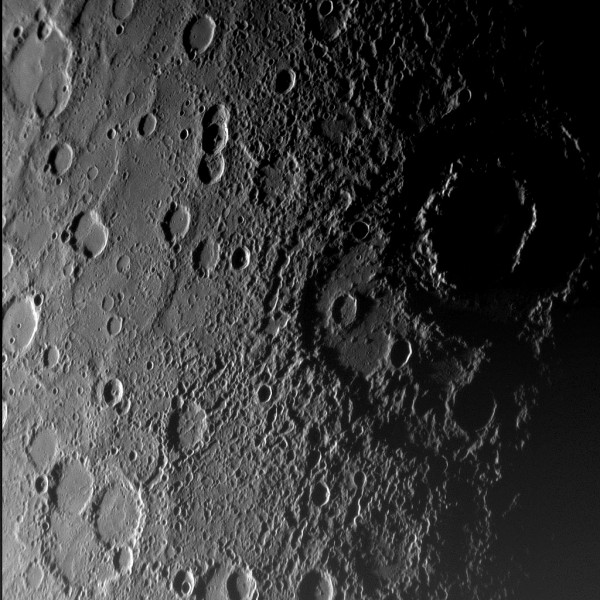
It's also loaded with very violent scars, such as those emanating from Spider Crater, shown here.
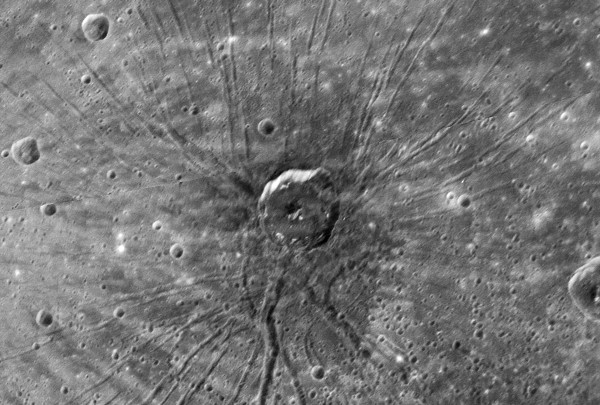
Additionally, there are some mysterious, high mountains, such as that black feature to the lower right of the image below.

And, I know it's just my own personal preferences, but I always enjoy images of the edge of the planet; of the border between bright, reflected sunlight and the blackness of deep space.
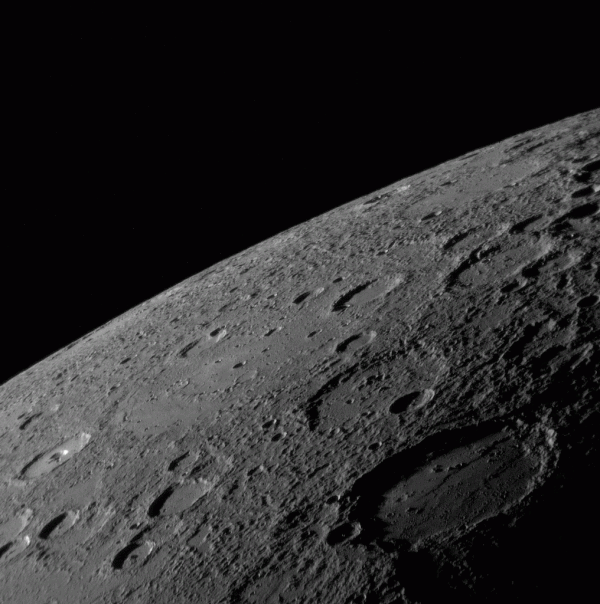
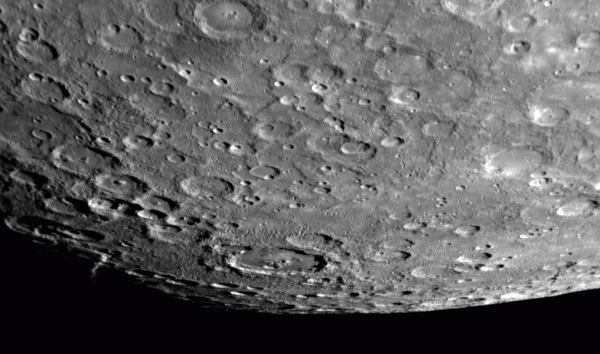
Mercury is made out of the densest, heaviest elements of any planet in the Solar System; if it weren't for the effect of gravity, Mercury would be even denser than the Earth. (We are #1, you know.)
But very recently, Messenger did something absolutely spectacular, that I'd previously only seen done from Saturn and the Moon before: looked back and saw us.
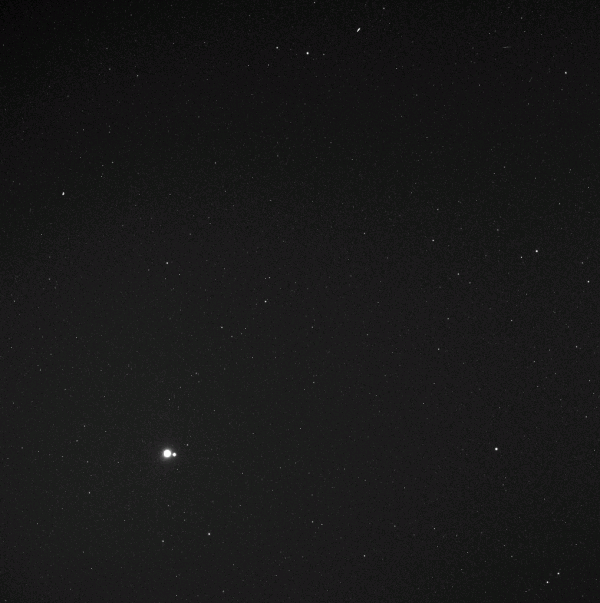
Do you see us? At the lower left of the image above, we're the big disk with the smaller disk next to it: our Moon! Let's blow it up for you:

The Earth and Moon always look almost entirely "full" as seen from Mercury, and this picture is no exception. Messenger will enter into orbit, permanently, around Mercury on March 18th of next year, but a picture like this always makes me appreciate just how small, fragile, and lonely our world is against the backdrop of deep space.
So I hope you're enjoying one of the most beautiful sights the Universe has to offer; it's the least I can do to usher in the new month!

It's too bad that the picture of Earth looks more white than blue. Also, I guess the moon was close to new, because it seems way too large and close to Earth.
Ethan, what a wonderful picture and thank you for sharing with the online population. It truely is remarkable when one can see the Earth and Moon from a different prospective. What will it be like, in the future, when the decendents of human colonist look at the Earth from the Moon or Mars? In the European colonial era, colonist were going to a New World in their move to South America, North America, or Australia. Today, the decendents look back and think of themself as belonging to the continent upon which they live: American, Canadian, Mexican, Brazilian, Australian, ect.
What will it be like for human society, in the future, when people begin to think of themself as Martian, Terran, or Lunarian?
"it's the least I can do to usher in the new month!"
That was nice...thanks. I needed that
:?)
And to think...someday, I will be reunited with that beautiful space.
Phenomenal images, as always. Your blog always has the best visual aids of any physics blog I read.
That Spider Crater looks distinctly implausible. Does anybody pretend to know how it got that way?
S.C., you have one fabulous blog going in your own right!
I've sent a lot of people your way for your post (deservedly) eviscerating Wun-Yi Shu's paper, and I look forward to reading more!
Sawn, I think the apparent relative sizes of the moon and Earth are artifacts of the optics. The Earth's diameter is about 4 x the moon's but here the moon looks about half as big. The Earth looks overexposed, and the moon's image is crisper, which is what I'd expect given the moon's low albedo. The moon is 1 pixel higher, which plays tricks. Given how pixilated the image is anyway, it would be hard to precisely determine their relative diameters. And I don't think it's a color image.
The moon would be brightly lit whether it was near new or near full to an Earth observer, and at this distance (~150,000,000 km earth to sun and rough average earth to Mercury v. 400,000 km earth to moon) it would not make any observable difference in the size.
There was a lot of great work done with the old vidicon tubes - Pioneer(s), Voyager(s), Mariner, Viking(s). Those ancient images still look incredible, and the newer images with CCDs are just unbelievable. Oh, and let's not forget the Russians and the first images of the far side of the moon courtesy of the Luna missions (and first printed in the USA, much to the disgust of Soviet authorities) or the other incredible Russian missions.
What about the really bright spots on Mercury?
is the crusent above the earth and to the left Venus.
According to Emily Lakdawalla's blog at the Planetary Society, that image was taken 6 May, which was third quarter for the Moon - so the Moon was near to maximum elongation from the Earth as seen from the Sun and Mercury's orbit generally (MESSENGER wasn't at Mercury at the time, of course). Since the Earth and Moon are much smaller than the distance between them, it follows that the 'discs' are almost entirely optical artefacts.
I think Earth has been photographed from Mars, too - forget which spacecraft.
Earth has been photographed from much further away than Mars. I'm surprised nobody has mentioned the Pale Blue Dot:
http://en.wikipedia.org/wiki/Pale_Blue_Dot
I find the vastness of space surrounding Earth even more impressive than the image taken from Mercury - and that's 'just' from the border of our solar system, which is where the rest of our galaxy starts - which is just one out of many, unknown ones.
The universe is truly unimaginably large and it saddens me we'll never be able to explore it.
That Spider Crater looks distinctly implausible. Does anybody pretend to know how it got that way?
Google is your friend. Messenger was the first platform to observe that feature, as announced in this press release (scroll down to image 5.6) from 30 January 2008. They give a tentative explanation there.
I believe Earth was photographed from Mars also?
Hinton, no, it is not Venus.
Consider the geometry: The sun is at the center, with Mercury, Venus, and Earth-and-moon orbiting successively farther out. The photo was taken from close to the sun, in about Mercury's orbit. Venus would always be farther away (but closer than Earth), so Venus would always be illuminated face-on. It would never appear crescent-shaped. (The outer planets Mars, Jupiter, and so forth never appear crescent-shaped from the Earth for the same reason. But Martians could observe a crescent-Earth.)
Venus is about the same size as the Earth. If it were anywhere in that picture, it would have to be approximately halfway between the Earth and Mercury, and thus appear about twice the size of the Earth in the picture.
Re, in the original article:
"Mercury is made out of the densest, heaviest elements of any planet in the Solar System; if it weren't for the effect of gravity, Mercury would be even denser than the Earth."
I don't understand what you mean by this. Could you explain more?
Awesome stuff - thanks !!
Yep, we're just a pale blue white dot from there.
Wow, they almost look like double planets.They could be, though, once the barycenter goes outside the Earth, which is like a long time from now.
How would I go about determining the angular distance between the Earth and the Moon in that image if I wanted to do the trig to find out how far away Messenger were when it took the picture? (Well, rather I'd get my pupils to do it.)
I especially like the view of our planet, when the blue slowly becomes black.The glare of our planet is spectacular. Can't wait for some new episode about space on National Geographic HD.
Earth/Moon as seen from Mercury orbit. Thank you. This is one of the most significant pictures I've ever seen, including Dali and Da Vinci. I felt a sense of HOME like never before.
Would not the moon always be full from Mercuryâs perspective?; except when it is being eclipsed by earth. I wonder what affect the stronger gravitation field is having on the light being reflected back toward the sun. Is it accelerated just a little bit? If it can be sucked into a black hole or bent by a gravitational lens would it not get to Mercury a little early. That is an experiment they should run.
<<>>
Purely based on it's material composition, Mercury would be denser as earth (more mass per volume), if they had equal gravity (mass), but since earth is heavier, it's material gets more compacted due to the gravitational force.